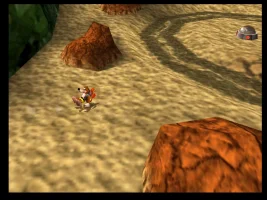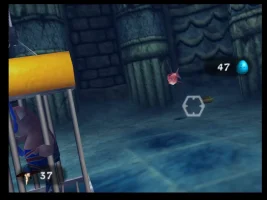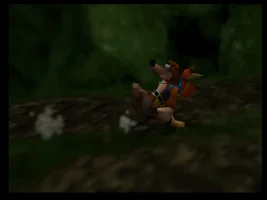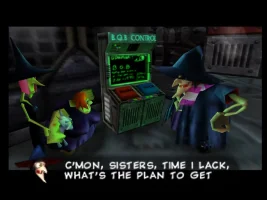Official Review
This comprehensive review examines Banjo-Tooie's interconnected world design, enhanced graphics, and challenging gameplay systems. We explore the game's expanded move set, innovative split-screen mechanics, and robust multiplayer features that differentiated it from its predecessor. Our analysis also considers how these elements contributed to the game's lasting influence on the platforming genre.
Gameplay and World Design
The expansive world of Banjo-Tooie revolutionizes the traditional platformer design with its intricate, interconnected gameplay systems. Unlike its predecessor, this N64 masterpiece presents a more complex and ambitious approach to level design and character abilities.
Larger, interconnected levels
The game's world structure represents a significant evolution, featuring massive environments that dwarf those of the original. Terrydactyland exemplifies this design philosophy with its towering central chamber and numerous branching paths. Each level connects seamlessly to others through hidden shortcuts and secret routes, creating a pseudo-Metroidvania experience. Changes made in one area can dramatically impact events in another, encouraging thorough exploration and strategic thinking.New moves and abilities
Throughout the adventure, players gradually expand their arsenal of moves through Jamjars' training system. These abilities are earned by collecting Musical Notes and finding training silos scattered across the worlds. The game thoughtfully introduces new mechanics, such as in Mayahem Temple, where players immediately put their newly acquired Egg Aim ability to use with strategically placed dragon statues. Key moves include:- Advanced egg-shooting techniques
- Enhanced swimming abilities
- Specialized climbing moves
- Character-specific abilities
Split-up gameplay mechanic
Perhaps the most innovative addition is the split-up mechanic, allowing players to separate Banjo and Kazooie using special blue and red pads. This system introduces an entirely new dimension to puzzle-solving and exploration. When separated, each character gains access to unique abilities and can tackle challenges independently. Players can switch between characters at will, creating opportunities for cooperative puzzle-solving where Banjo and Kazooie must work in tandem from different positions.The split-up feature particularly shines in complex environmental puzzles, where one character might need to activate mechanisms while the other navigates through newly opened paths. This mechanic transforms simple platforming challenges into more sophisticated puzzles that require careful planning and coordination between both characters.
The game's level design brilliantly accommodates these expanded gameplay systems, offering multiple paths and solutions based on which abilities or characters players choose to use. Grunty Industries stands out as a prime example, featuring some of the most intricate puzzles that cleverly utilize the split-up mechanic and various transformations to create challenging yet rewarding scenarios.
Graphics and Sound
Visually, Banjo-Tooie represents a significant technical achievement for the Nintendo 64, pushing the console's capabilities without requiring the expensive RAM expansion pack. The game's technical prowess is evident in every frame, from its sophisticated lighting systems to its intricate character animations.
Improved visuals and draw distance
The game showcases remarkable visual enhancements over its predecessor, featuring dynamic lighting that responds to player actions. When Kazooie shoots fire eggs in dark areas, the surrounding space illuminates dynamically, creating atmospheric effects previously unseen in N64 platformers. The attention to detail extends to character animations:- Banjo's backpack actively bounces and opens when Kazooie emerges
- Water surfaces feature fluid animations, unlike the static water in the original
- Character models display improved texturing and color consistency
- Environmental objects, including honeycomb pieces, feature unique animation patterns
Enhanced soundtrack and audio effects
Grant Kirkhope returns as composer, crafting a more atmospheric musical experience that perfectly complements the game's expanded scope. The soundtrack takes a notably different approach from its predecessor, focusing on creating distinct moods for each environment. Atlantis and Grunty Industries stand out as particularly memorable compositions, where the music perfectly captures the essence of these unique locations.The game's audio design introduces environmental sound effects that blend seamlessly with the background music. From the bubbling lava in Hailfire Peaks to the ethereal echoes in underwater sections, these audio cues enhance the player's immersion. However, this integration occasionally results in sound effects competing with the musical score, particularly noticeable in aquatic areas where swimming sounds can overshadow the background themes.
The technical achievements in Banjo-Tooie's presentation came at a cost, with the game occasionally struggling to maintain consistent performance on the original hardware. However, these limitations hardly diminish the impressive artistic vision achieved by Rare's development team. The game's visual style, characterized by bright, expressive environments and detailed texturing, creates a distinct esthetic that has aged remarkably well, especially when compared to other titles from the same era.
Challenges and Collectibles
Building upon the foundation of its predecessor, Banjo-Tooie elevates the challenge factor with intricate puzzles and an expanded collection of mini-games that test players' skills to their limits. The game's difficulty curve represents a significant departure from traditional platformer design, offering a more complex and demanding experience.
Increased difficulty
The game's progression system introduces a sophisticated approach to challenge, particularly evident in later worlds like Terrydactyland and Grunty Industries. These areas demand mastery of multiple abilities, often requiring players to backtrack between levels to acquire necessary moves. The introduction of Minjos—hostile creatures disguised as friendly Jinjos—adds an extra layer of caution to exploration, forcing players to approach seemingly harmless situations with strategic thinking.New mini-games and boss battles
Banjo-Tooie revolutionizes boss encounters with dramatic introductions and on-screen titles, transforming each confrontation into a memorable event. These battles demand more tactical approach and endurance compared to the original game. Notable mini-games include:- Mayan Kickball Championship with progressive difficulty tiers
- Ordnance Storage challenge with strict time limitations
- Dodgems Challenge featuring strategic vehicle combat
- Tower of Tragedy Quiz Show testing player knowledge
Expanded collectible system
While maintaining the same quantity of collectibles as its predecessor, Banjo-Tooie reimagines how players interact with these items. The collection mechanics now integrate more deeply with the game's interconnected world design. Jiggies often require solving multi-step puzzles that span multiple levels, creating a more intricate collection experience.The game introduces a tiered reward system where:
- Basic collectibles remain accessible to casual players
- Advanced items require mastery of specific abilities
- Ultimate rewards demand comprehensive knowledge of game mechanics
The difficulty spike becomes particularly evident in the final three levels, where specific moves and items become mandatory for progression. This design choice, while potentially frustrating for newcomers, creates a satisfying sense of accomplishment for those who master the game's systems. The addition of Cheato pages and expanded honeycomb pieces provides players with strategic choices about when and how to enhance their capabilities, adding another layer of tactical decision-making to the collection process.
Legacy and Replayability
Time has offered a unique perspective on Banjo-Tooie's ambitious design choices and their impact on the gaming landscape. While the game pushed boundaries in numerous ways, its legacy is both celebrated and debated within the gaming community.
Comparison to Banjo-Kazooie
The relationship between Banjo-Tooie and its predecessor presents an interesting study in game design philosophy. Where Banjo-Kazooie offered a more focused, compact experience, Tooie expanded in every conceivable direction. This expansion manifests in several key areas:| Aspect | Banjo-Kazooie | Banjo-Tooie |
|---|---|---|
| World Design | Condensed, focused levels | Vast, interconnected environments |
| Gameplay Structure | Exploration-centric | Task-based with backtracking |
| Move Set | Core abilities | Expanded movement options |
| Level Flow | Self-contained worlds | Interconnected areas |
Designer Greg Mayles later reflected that while the team believed Tooie's complex, interlocking worlds represented an improvement, many fans still prefer the original's simpler structure. This perspective highlights an important lesson in game design: bigger isn't always better.
Lasting impact on 3D platformers
Banjo-Tooie's influence on the platforming genre extends beyond its immediate release. The game's approach to world design and interconnectivity predated many modern open-world concepts. Its emphasis on puzzle-solving and exploration over pure platforming challenged conventional genre norms.The game's most enduring contributions include:
- Integration of shooting mechanics in a platformer
- Complex multi-character puzzle design
- Interconnected world systems
- Advanced character progression mechanics
Multiplayer mode
One of Banjo-Tooie's most significant additions was its comprehensive multiplayer mode, which expanded the game's appeal beyond single-player adventures. The mode offers fourteen distinct mini-games, ranging from competitive shootouts to quiz shows, supporting up to four players in local multiplayer.The multiplayer experience features several innovative aspects:
- Customizable rule sets for shooter-style games
- Character selection with unique attributes
- Multiple game types including team-based modes
- Variety of maps and challenges
The mode's implementation shows remarkable attention to detail, with each character featuring distinct attributes. For instance, the Jinjo character offers increased speed but reduced health, while Grunty moves slower but can sustain more damage. These balancing choices create interesting strategic decisions in competitive play.
Looking back, Banjo-Tooie represents a fascinating moment in gaming history where ambition and technical limitations collided. While some of its design choices may have overreached, its willingness to push boundaries and experiment with established formulas helped shape the evolution of 3D platformers. The game's legacy lives on through its influence on modern game design, even as developers continue to debate the merits of its more complex approach to the genre.
Conclusion
Banjo-Tooie stands as a remarkable testament to Rare's creative ambition during the Nintendo 64 era. Through its interconnected worlds, innovative split-screen mechanics, and expanded gameplay systems, the game pushed beyond conventional platforming boundaries. These technical achievements, combined with enhanced visuals and Grant Kirkhope's atmospheric soundtrack, created an experience that challenged players while maintaining the series' signature charm, despite occasional performance limitations.
Twenty years later, Banjo-Tooie's influence resonates throughout modern game design. Many contemporary titles draw inspiration from its interconnected world structure and multi-character puzzle mechanics, though often with more measured implementation. The game's willingness to experiment with established formulas, even when risking complexity over accessibility, helped shape the evolution of 3D platformers and secured its place as a significant milestone in gaming history.






